Hierarchical Structure and Properties of the Bone at Nano Level
Abstract
1. Introduction
2. Materials and Method
2.1. Computational 3D Modeling at Nano Level
2.2. Molecular Dynamics Simulation (MDS)
2.3. Forcefield
3. Results and Discussion
3.1. Validation with Experimental Work
3.2. Prediction Equation
4. Conclusions
Author Contributions
Funding
Institutional Review Board Statement
Informed Consent Statement
Data Availability Statement
Acknowledgments
Conflicts of Interest
References
- Park, J.; Lakes, R.S. Biomaterials: An Introduction; Springer Science & Business Media: Berlin/Heidelberg, Germany, 2007. [Google Scholar]
- Karsdal, M. Biochemistry of Collagens, Laminins and Elastin: Structure, Function and Biomarkers; Academic Press: Cambridge, MS, USA, 2019. [Google Scholar]
- Shoulders, M.D.; Raines, R.T. Collagen structure and stability. Annu. Rev. Biochem. 2009, 78, 929–958. [Google Scholar] [CrossRef] [PubMed]
- Burr, D.B.; Allen, M.R. (Eds.) Basic and Applied Bone Biology, 2nd ed.; Academic Press: Cambridge, MS, USA, 2019; ISBN 9780128132593. [Google Scholar]
- Alvarez, K.; Nakajima, H. Metallic scaffolds for bone regeneration. Materials 2009, 2, 790–832. [Google Scholar] [CrossRef]
- Liebi, M.; Georgiadis, M.; Menzel, A.; Schneider, P.; Kohlbrecher, J.; Bunk, O.; Guizar-Sicairos, M. Nanostructure surveys of macroscopic specimens by small-angle scattering tensor tomography. Nature 2015, 527, 349. [Google Scholar] [CrossRef] [PubMed]
- Burr, D.B.; Allen, M.R. (Eds.) Basic and Applied Bone Biology; Academic Press: Cambridge, MS, USA, 2013. [Google Scholar]
- Steiner, R.D.; Basel, D. COL1A1/2 Osteogenesis Imperfecta. In GeneReviews®[Internet]; University of Washington: Seattle, WA, USA, 2019. [Google Scholar]
- Marini, J.C.; Cabral, W.A. Osteogenesis Imperfecta. In Genetics of Bone Biology and Skeletal Disease; Academic Press: Cambridge, MS, USA, 2018; pp. 397–420. [Google Scholar]
- Forlino, A.; Marini, J.C. Osteogenesis imperfecta. Lancet 2016, 387, 1657–1671. [Google Scholar] [CrossRef]
- Rauch, F.; Glorieux, F.H. Osteogenesis imperfecta. Lancet 2004, 363, 1377–1385. [Google Scholar] [CrossRef]
- Beck, K.; Chan, V.C.; Shenoy, N.; Kirkpatrick, A.; Ramshaw, J.A.; Brodsky, B. Destabilization of osteogenesis imperfecta collagen-like model peptides correlates with the identity of the residue replacing glycine. Proc. Natl. Acad. Sci. USA 2000, 97, 4273–4278. [Google Scholar] [CrossRef]
- Eren, E.D.; Nijhuis, W.H.; van der Weel, F.; Dede Eren, A.; Ansari, S.; Bomans, P.H.; Friedrich, H.; Sakkers, R.J.; Weinans, H.; de With, G. Multiscale characterization of pathological bone tissue. Microsc. Res. Tech. 2022, 85, 469–486. [Google Scholar] [CrossRef]
- Schrof, S.; Varga, P.; Galvis, L.; Raum, K.; Masic, A. 3D Raman mapping of the collagen fibril orientation in human osteonal lamellae. J. Struct. Biol. 2014, 187, 266–275. [Google Scholar] [CrossRef]
- Buchwald, T.; Kozielski, M.; Szybowicz, M. Determination of collagen fibers arrangement in bone tissue by using transformations of Raman spectra maps. J. Spectrosc. 2012, 27, 107–117. [Google Scholar] [CrossRef]
- Bi, X.; Li, G.; Doty, S.B.; Camacho, N.P. A novel method for determination of collagen orientation in cartilage by Fourier transform infrared imaging spectroscopy (FT-IRIS). Osteoarthr. Cartil. 2005, 13, 1050–1058. [Google Scholar] [CrossRef]
- Couture, C.A.; Bancelin, S.; Van der Kolk, J.; Popov, K.; Rivard, M.; Légaré, K.; Martel, G.; Richard, H.; Brown, C.; Laverty, S.; et al. The impact of collagen fibril polarity on second harmonic generation microscopy. Biophys. J. 2015, 109, 2501–2510. [Google Scholar] [CrossRef] [PubMed]
- Chen, X.; Nadiarynkh, O.; Plotnikov, S.; Campagnola, P.J. Second harmonic generation microscopy for quantitative analysis of collagen fibrillar structure. Nat. Protoc. 2012, 7, 654. [Google Scholar] [CrossRef] [PubMed]
- Robitaille, M.C.; Zareian, R.; DiMarzio, C.A.; Wan, K.T.; Ruberti, J.W. Small-angle light scattering to detect strain-directed collagen degradation in native tissue. Interface Focus 2011, 1, 767–776. [Google Scholar] [CrossRef] [PubMed]
- Arifler, D.; Pavlova, I.; Gillenwater, A.; Richards-Kortum, R. Light scattering from collagen fiber networks: Micro-optical properties of normal and neoplastic stroma. Biophys. J. 2007, 92, 3260–3274. [Google Scholar] [CrossRef] [PubMed]
- Silva, H.; Tassone, C.; Ross, E.G.; Lee, J.T.; Zhou, W.; Nelson, D. Collagen Fibril Orientation in Tissue Specimens From Atherosclerotic Plaque Explored Using Small Angle X-Ray Scattering. J. Biomech. Eng. 2022, 144. [Google Scholar] [CrossRef] [PubMed]
- Guizar-Sicairos, M.; Georgiadis, M.; Liebi, M. Validation study of small-angle X-ray scattering tensor tomography. J. Synchrotron Radiat. 2020, 27, 779–787. [Google Scholar] [CrossRef]
- Kostyuk, O.; Brown, R.A. Novel spectroscopic technique for in situ monitoring of collagen fibril alignment in gels. Biophys. J. 2004, 87, 648–655. [Google Scholar] [CrossRef][Green Version]
- Kostyuk, O.; Birch, H.L.; Mudera, V.; Brown, R.A. Structural changes in loaded equine tendons can be monitored by a novel spectroscopic technique. J. Physiol. 2004, 554, 791–801. [Google Scholar] [CrossRef]
- Georgiadis, M.; Müller, R.; Schneider, P. Techniques to assess bone ultrastructure organization: Orientation and arrangement of mineralized collagen fibrils. J. R. Soc. Interface 2016, 13, 20160088. [Google Scholar] [CrossRef]
- McNally, E.A.; Schwarcz, H.P.; Botton, G.A.; Arsenault, A.L. A model for the ultrastructure of bone based on electron microscopy of ion-milled sections. PLoS ONE 2012, 7, e29258. [Google Scholar] [CrossRef]
- Shah, F.A.; Ruscsák, K.; Palmquist, A. 50 years of scanning electron microscopy of bone—A comprehensive overview of the important discoveries made and insights gained into bone material properties in health, disease, and taphonomy. Bone Res. 2019, 7, 1–15. [Google Scholar] [CrossRef] [PubMed]
- Hänninen, N.; Rautiainen, J.; Rieppo, L.; Saarakkala, S.; Nissi, M.J. Orientation anisotropy of quantitative MRI relaxation parameters in ordered tissue. Sci. Rep. 2017, 7, 9606. [Google Scholar] [CrossRef] [PubMed]
- Osaki, S.; Tohno, S.; Tohno, Y.; Ohuchi, K.; Takakura, Y. Determination of the orientation of collagen fibers in human bone. Anat. Rec. Off. Publ. Am. Assoc. Anat. 2002, 266, 103–107. [Google Scholar] [CrossRef] [PubMed]
- Andriotis, O.G.; Chang, S.W.; Vanleene, M.; Howarth, P.H.; Davies, D.E.; Shefelbine, S.J.; Buehler, M.J.; Thurner, P.J. Structure–mechanics relationships of collagen fibrils in the osteogenesis imperfecta mouse model. J. R. Soc. Interface 2015, 12, 20150701. [Google Scholar] [CrossRef] [PubMed]
- Shen, Z.L.; Dodge, M.R.; Kahn, H.; Ballarini, R.; Eppell, S.J. Stress-strain experiments on individual collagen fibrils. Biophys. J. 2008, 95, 3956–3963. [Google Scholar] [CrossRef]
- Fratzl, P.; Gupta, H.S.; Paschalis, E.P.; Roschger, P. Structure and mechanical quality of the collagen–mineral nano-composite in bone. J. Mater. Chem. 2004, 14, 2115–2123. [Google Scholar] [CrossRef]
- Rho, J.Y.; Zioupos, P.; Currey, J.D.; Pharr, G.M. Microstructural elasticity and regional heterogeneity in human femoral bone of various ages examined by nano-indentation. J. Biomech. 2002, 35, 189–198. [Google Scholar] [CrossRef]
- Ji, B. A study of the interface strength between protein and mineral in biological materials. J. Biomech. 2008, 41, 259–266. [Google Scholar] [CrossRef]
- Gao, H. Application of fracture mechanics concepts to hierarchical biomechanics of bone and bone-like materials. Int. J. Fract. 2006, 138, 101. [Google Scholar] [CrossRef]
- Ji, B.; Gao, H. Mechanical properties of nanostructure of biological materials. J. Mech. Phys. Solids 2004, 52, 1963–1990. [Google Scholar] [CrossRef]
- Jäger, I.; Fratzl, P. Mineralized collagen fibrils: A mechanical model with a staggered arrangement of mineral particles. Biophys. J. 2000, 79, 1737–1746. [Google Scholar] [CrossRef]
- Buehler, M.J. Molecular nanomechanics of nascent bone: Fibrillar toughening by mineralization. Nanotechnology 2007, 18, 295102. [Google Scholar] [CrossRef]
- Zhang, D.; Chippada, U.; Jordan, K. Effect of the structural water on the mechanical properties of collagen-like microfibrils: A molecular dynamics study. Ann. Biomed. Eng. 2007, 35, 1216–1230. [Google Scholar] [CrossRef] [PubMed]
- Buehler, M.J. Nature designs tough collagen: Explaining the nanostructure of collagen fibrils. Proc. Natl. Acad. Sci. USA 2006, 103, 12285–12290. [Google Scholar] [CrossRef] [PubMed]
- Chang, S.W.; Shefelbine, S.J.; Buehler, M.J. Structural and mechanical differences between collagen homo-and heterotrimers: Relevance for the molecular origin of brittle bone disease. Biophys. J. 2012, 102, 640–648. [Google Scholar] [CrossRef] [PubMed]
- Bose, S.; Li, S.; Mele, E.; Silberschmidt, V.V. Exploring the Mechanical Properties and Performance of Type-I Collagen at Various Length Scales: A Progress Report. Materials 2022, 15, 2753. [Google Scholar] [CrossRef]
- Yang, L.; van der Werf, K.O.; Koopman, B.F.; Subramaniam, V.; Bennink, M.L.; Dijkstra, P.J.; Feijen, J. Micromechanical bending of single collagen fibrils using atomic force microscopy. J. Biomed. Mater. Res. Part A 2007, 82, 160–168. [Google Scholar] [CrossRef]
- Laws, N. A note on penny-shaped cracks in transversely isotropic materials. Mech. Mater. 1985, 4, 209–212. [Google Scholar] [CrossRef]
- Georgiadis, M.; Guizar-Sicairos, M.; Gschwend, O.; Hangartner, P.; Bunk, O.; Müller, R.; Schneider, P. Ultrastructure organization of human trabeculae assessed by 3D sSAXS and relation to bone microarchitecture. PLoS ONE 2016, 11, e0159838. [Google Scholar] [CrossRef]
- Bhowmik, R.; Katti, K.S.; Katti, D. Molecular dynamics simulation of hydroxyapatite–polyacrylic acid interfaces. Polymer 2007, 48, 664–674. [Google Scholar] [CrossRef]
- Hauptmann, S.; Dufner, H.; Brickmann, J.; Kast, S.M.; Berry, R.S. Potential energy function for apatites. Phys. Chem. Chem. Phys. 2003, 5, 635–639. [Google Scholar] [CrossRef]
- Ponder, J.W.; Case, D.A. Force Fields for Protein Simulations. In Advances in Protein Chemistry; Academic Press: Cambridge, MS, USA, 2003; Volume 66, pp. 27–85. [Google Scholar]
- Zhao, W.; Xu, Z.; Cui, Q.; Sahai, N. Predicting the structure–activity relationship of hydroxyapatite-binding peptides by enhanced-sampling molecular simulation. Langmuir 2016, 32, 7009–7022. [Google Scholar] [CrossRef]
- Jia, Z. Molecular Mechanics Studies of Protein Signaling and Conformation Change. Ph.D. Thesis, Clemson University, Clemson, SC, USA, 2016. [Google Scholar]
- Qu, T.; Verma, D.; Alucozai, M.; Tomar, V. Influence of interfacial interactions on deformation mechanism and interface viscosity in α-chitin–calcite interfaces. Acta Biomater. 2015, 25, 325–338. [Google Scholar] [CrossRef] [PubMed]
- Dubey, D.K.; Tomar, V. Role of the nanoscale interfacial arrangement in mechanical strength of tropocollagen–hydroxyapatite-based hard biomaterials. Acta Biomater. 2009, 5, 2704–2716. [Google Scholar] [CrossRef] [PubMed]
- Hornak, V.; Abel, R.; Okur, A.; Strockbine, B.; Roitberg, A.; Simmerling, C. Comparison of multiple Amber force fields and development of improved protein backbone parameters. Proteins Struct. Funct. Bioinform. 2006, 65, 712–725. [Google Scholar] [CrossRef] [PubMed]
- In, Y.; Amornkitbamrung, U.; Hong, M.H.; Shin, H. On the crystallization of hydroxyapatite under hydrothermal conditions: Role of sebacic acid as an additive. ACS Omega 2020, 5, 27204–27210. [Google Scholar] [CrossRef]
- Hamandi, F.; Goswami, T. Macrodamage accumulation model for a human femur. Appl. Bionics Biomech. 2017, 2017, 4539178. [Google Scholar] [CrossRef]
- Gupta, H.S.; Seto, J.; Wagermaier, W.; Zaslansky, P.; Boesecke, P.; Fratzl, P. Cooperative deformation of mineral and collagen in bone at the nanoscale. Proc. Natl. Acad. Sci. USA 2006, 103, 17741–17746. [Google Scholar] [CrossRef]
- Liu, Y.; Ballarini, R.; Eppell, S.J. Tension tests on mammalian collagen fibrils. Interface Focus 2016, 6, 20150080. [Google Scholar] [CrossRef]
- Yamamoto, N. Tensile Strength of Single Collagen Fibrils Isolated from Tendons. Eur. J. Biophys. 2017, 5, 1. [Google Scholar] [CrossRef]
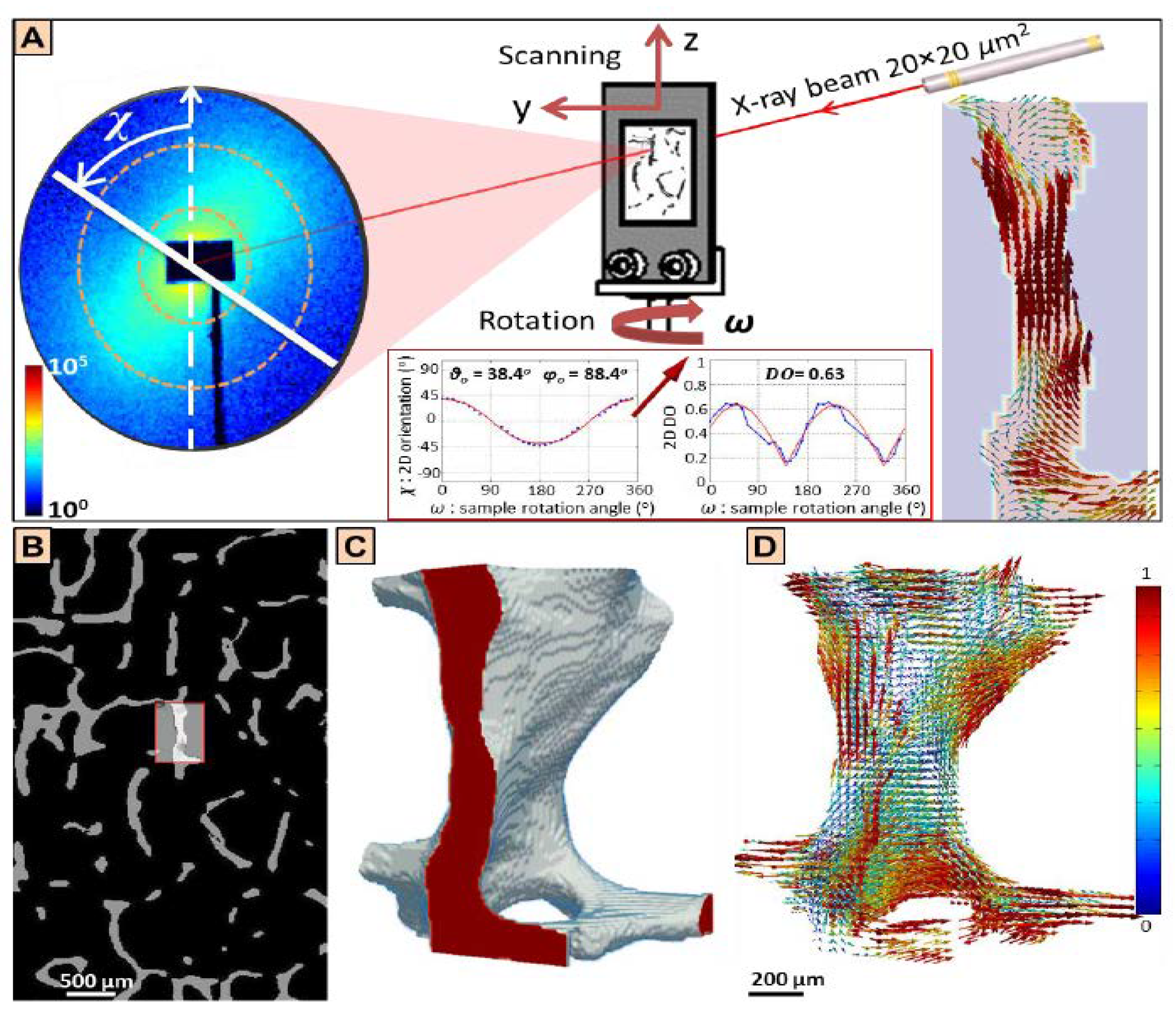
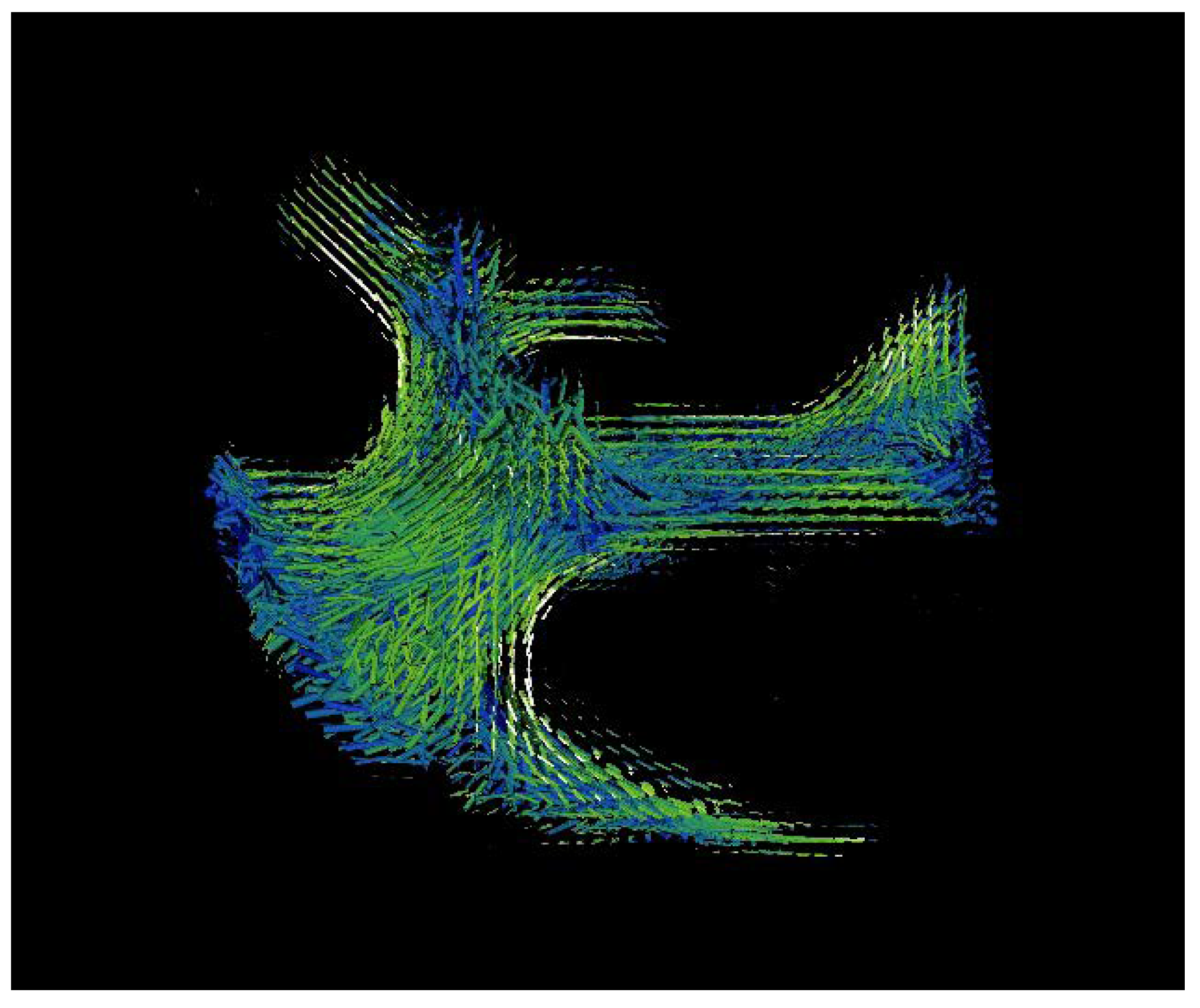
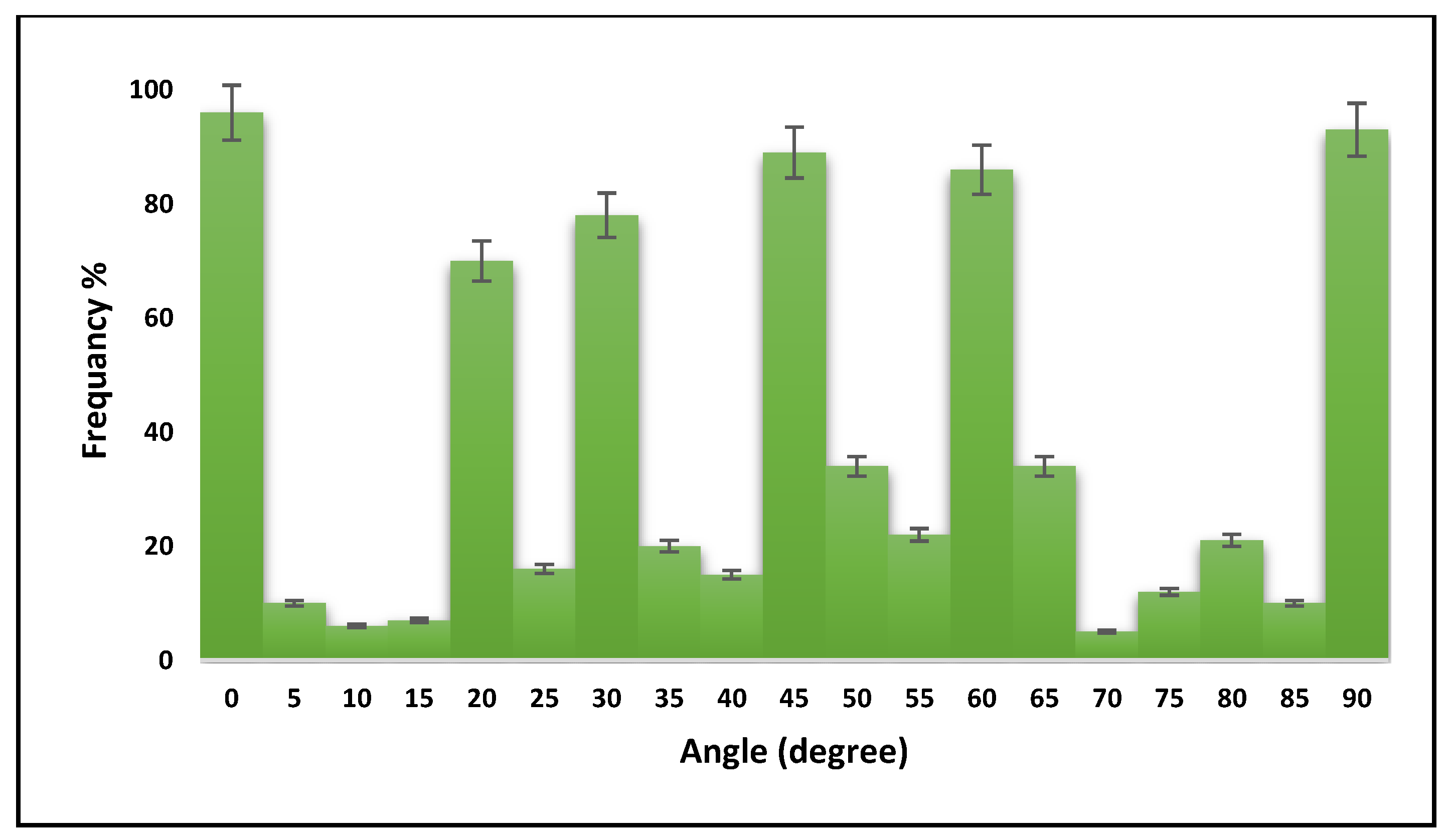
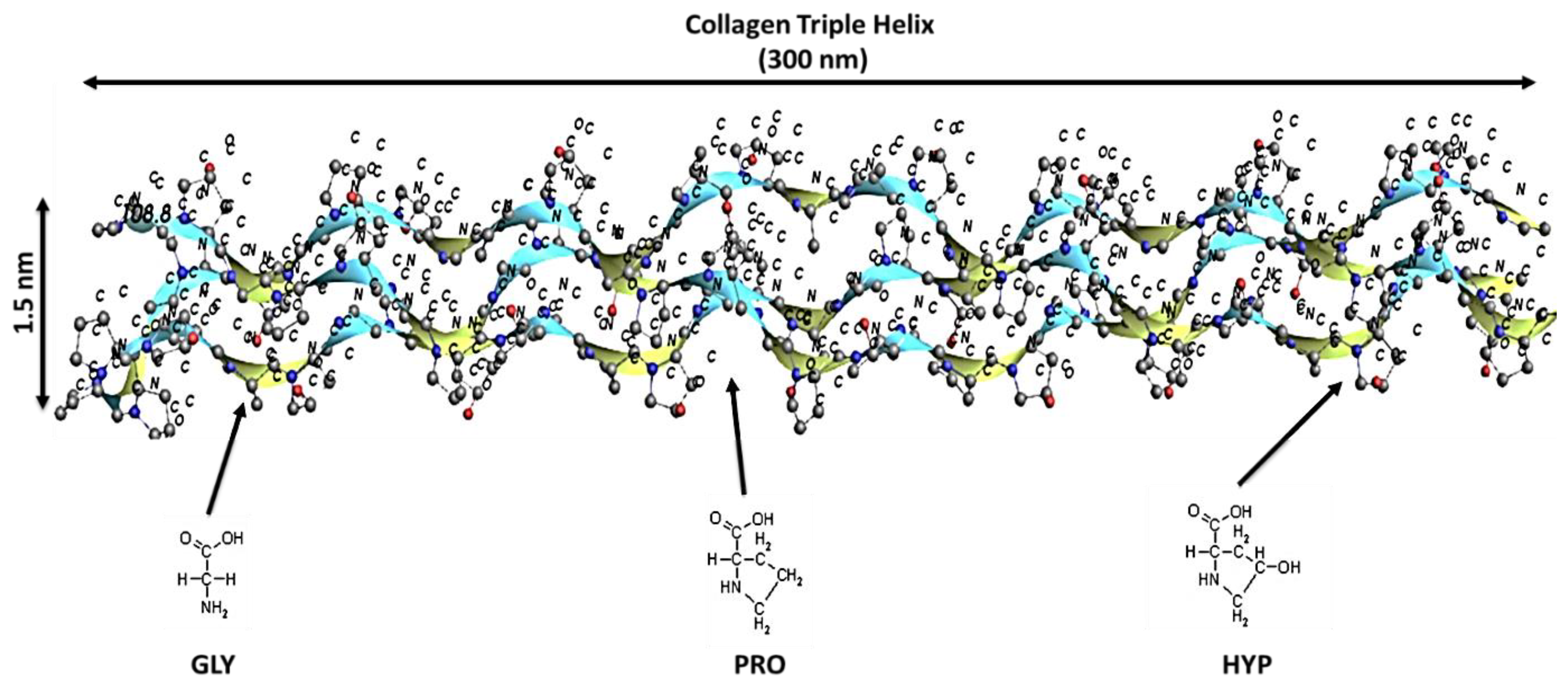
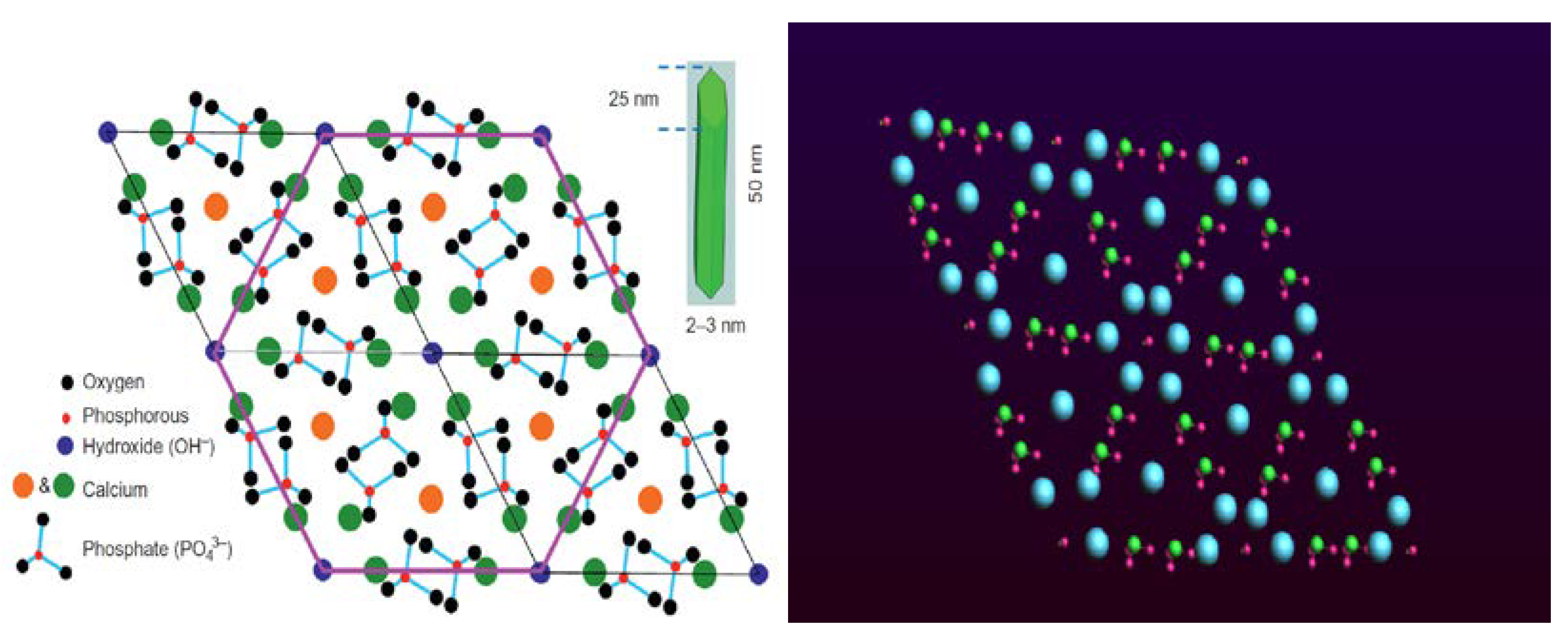
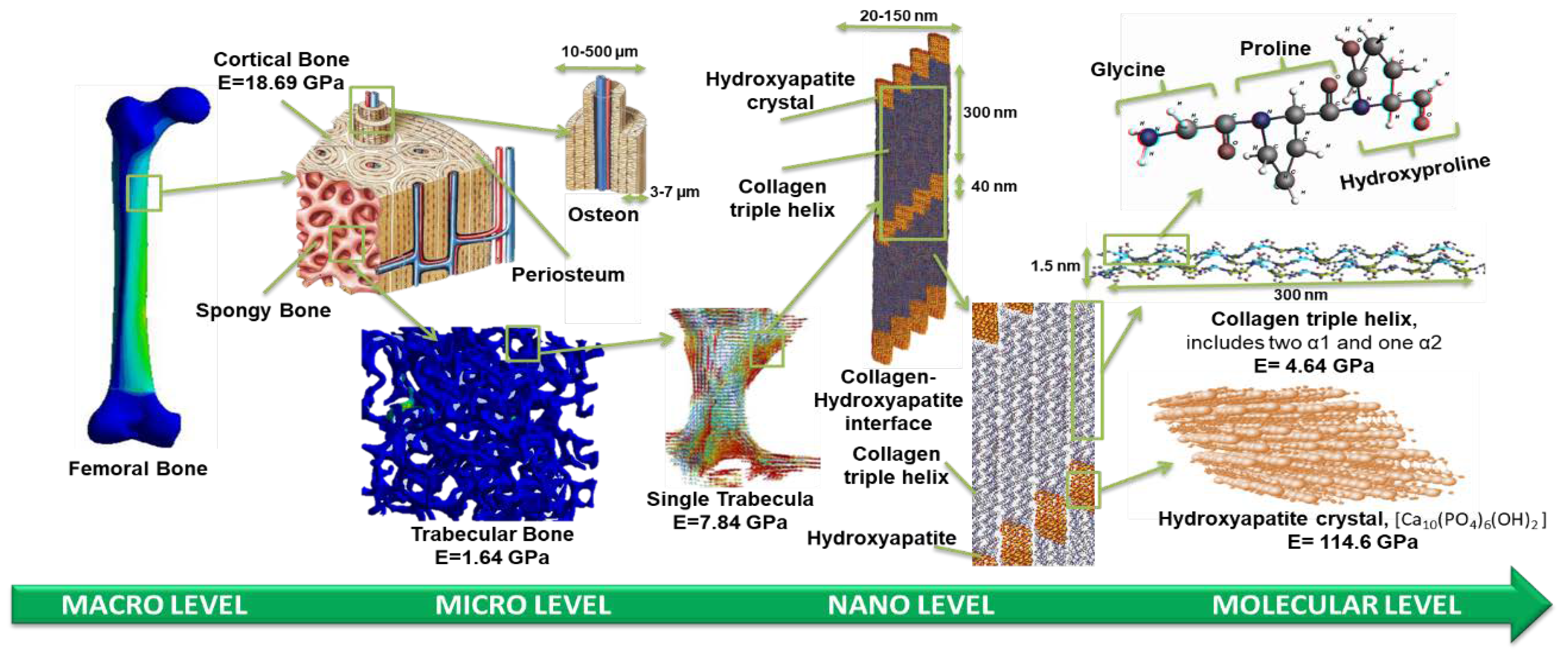

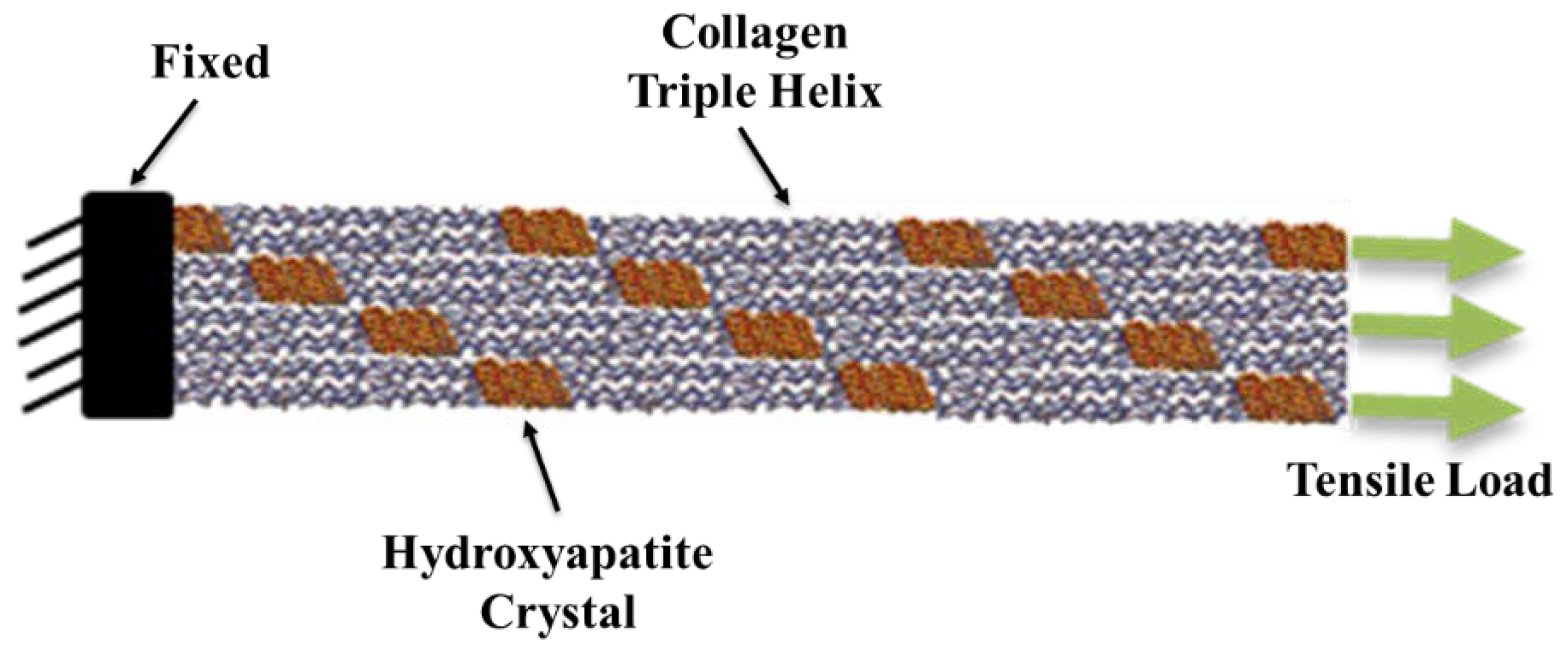
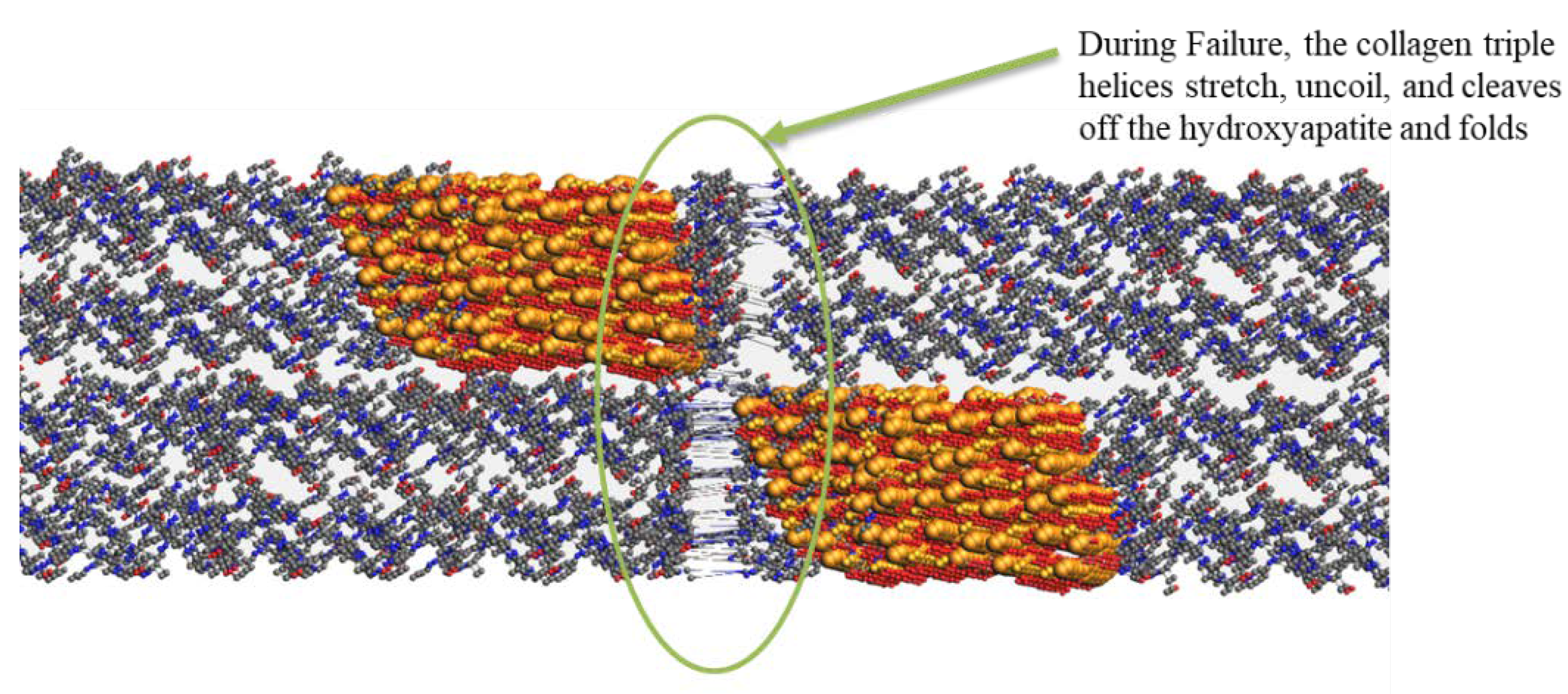
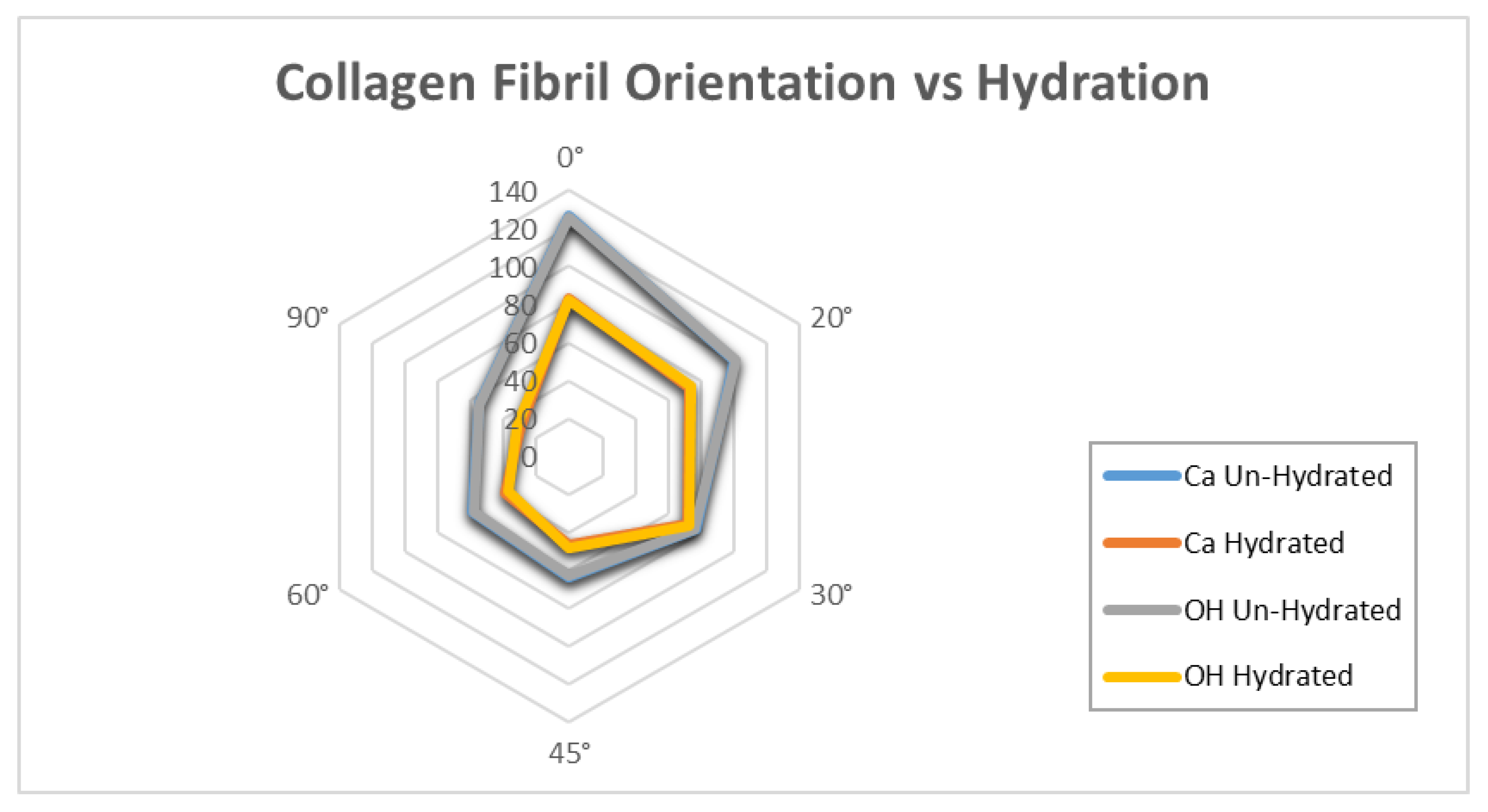



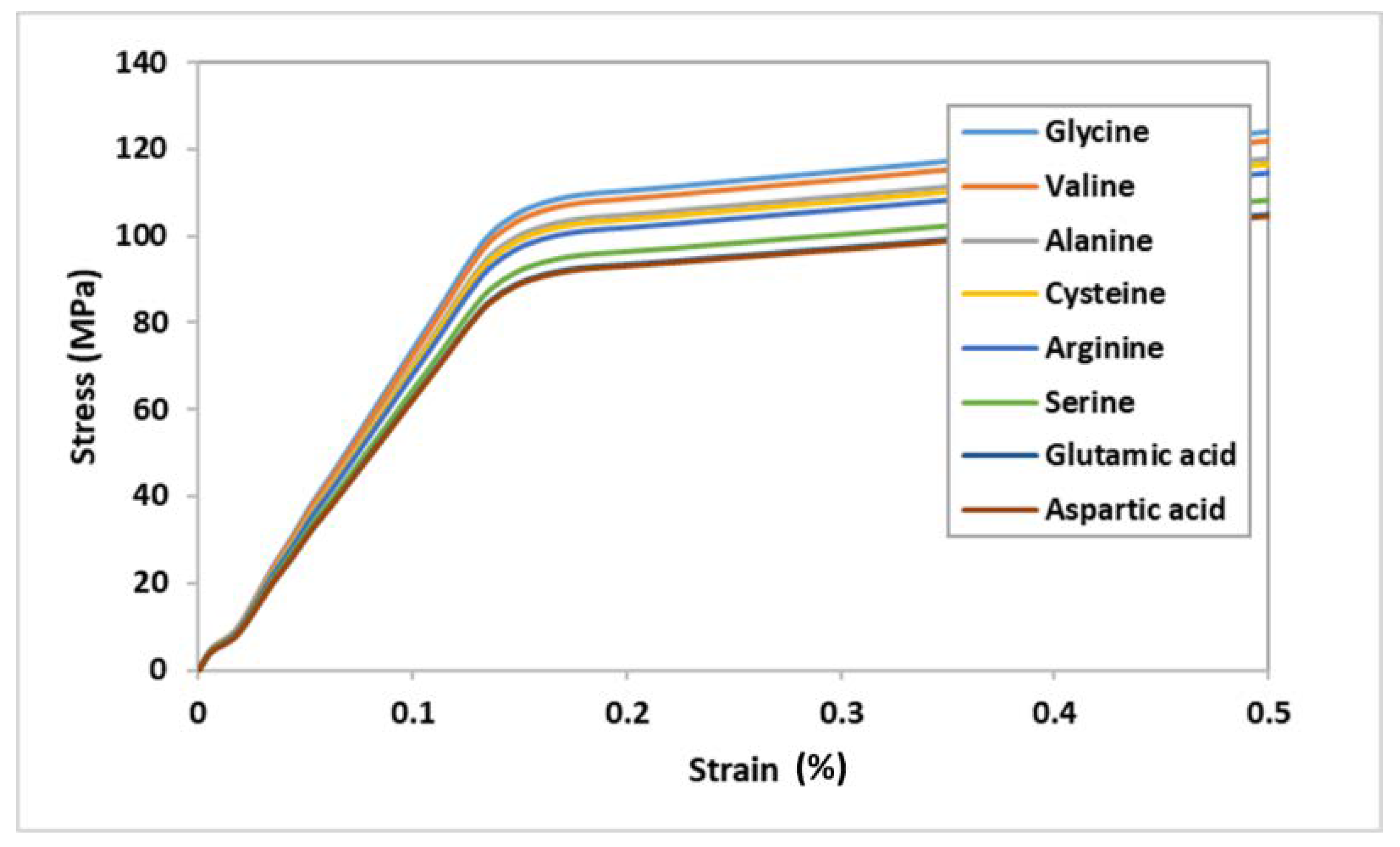
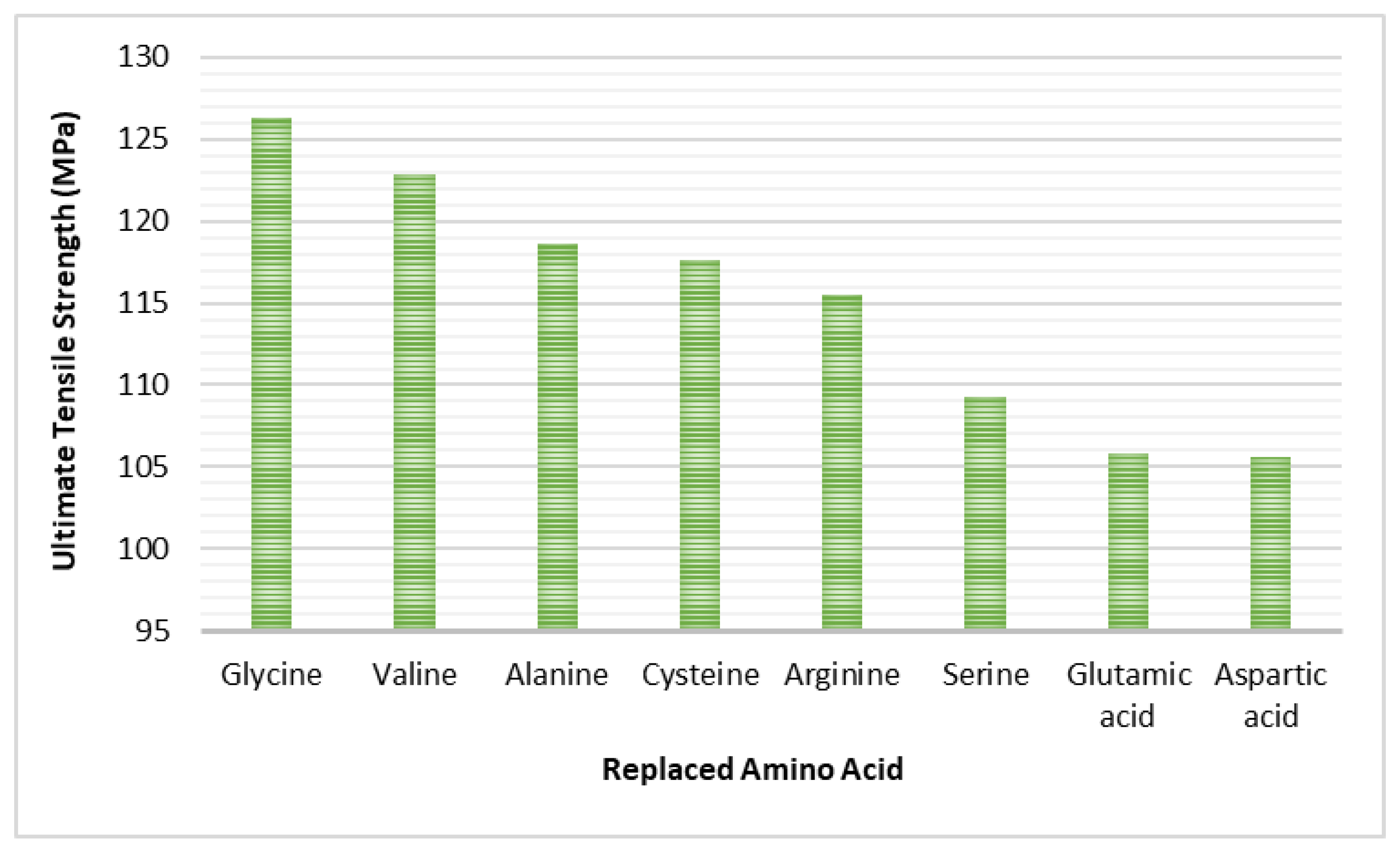
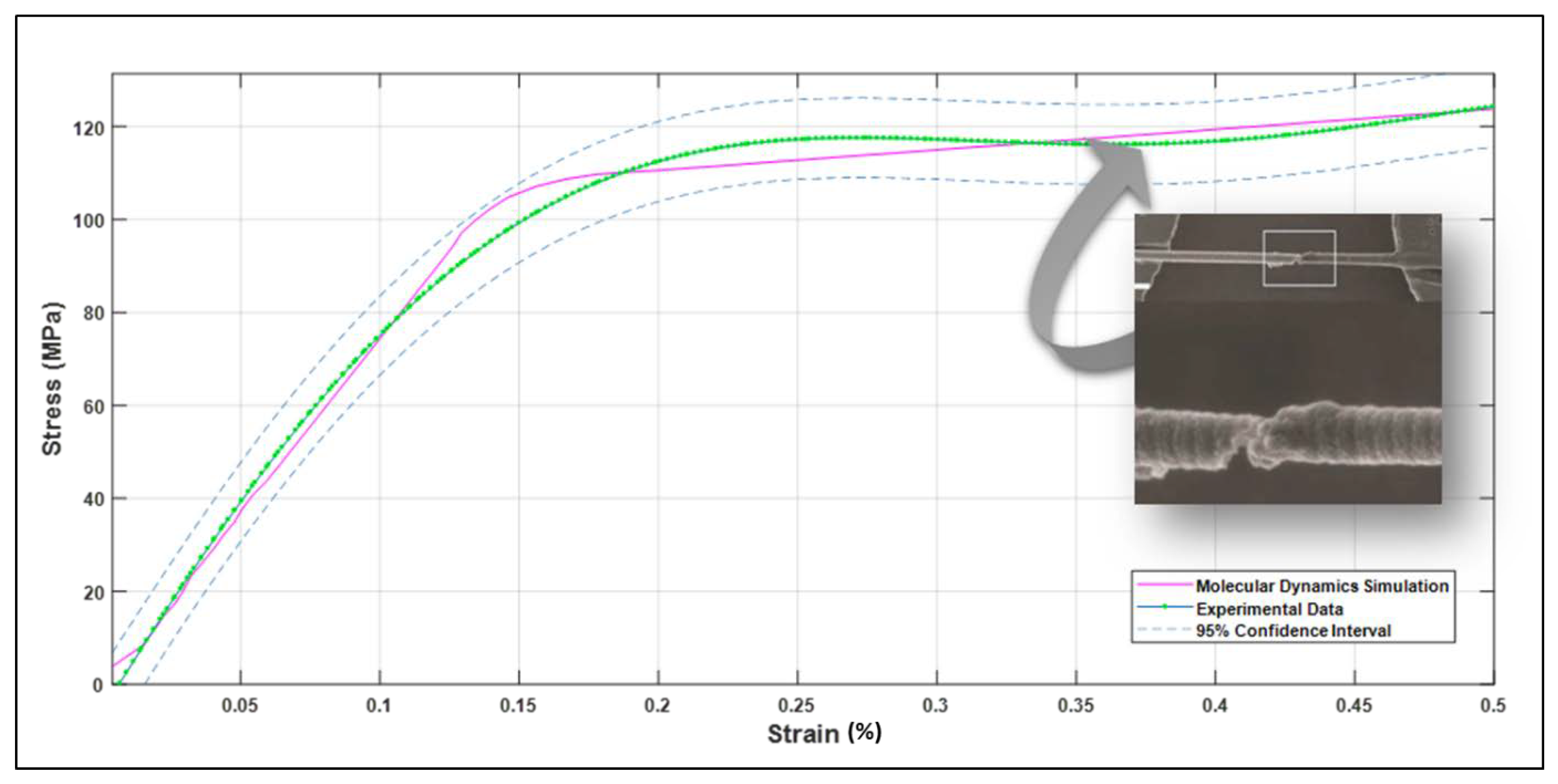
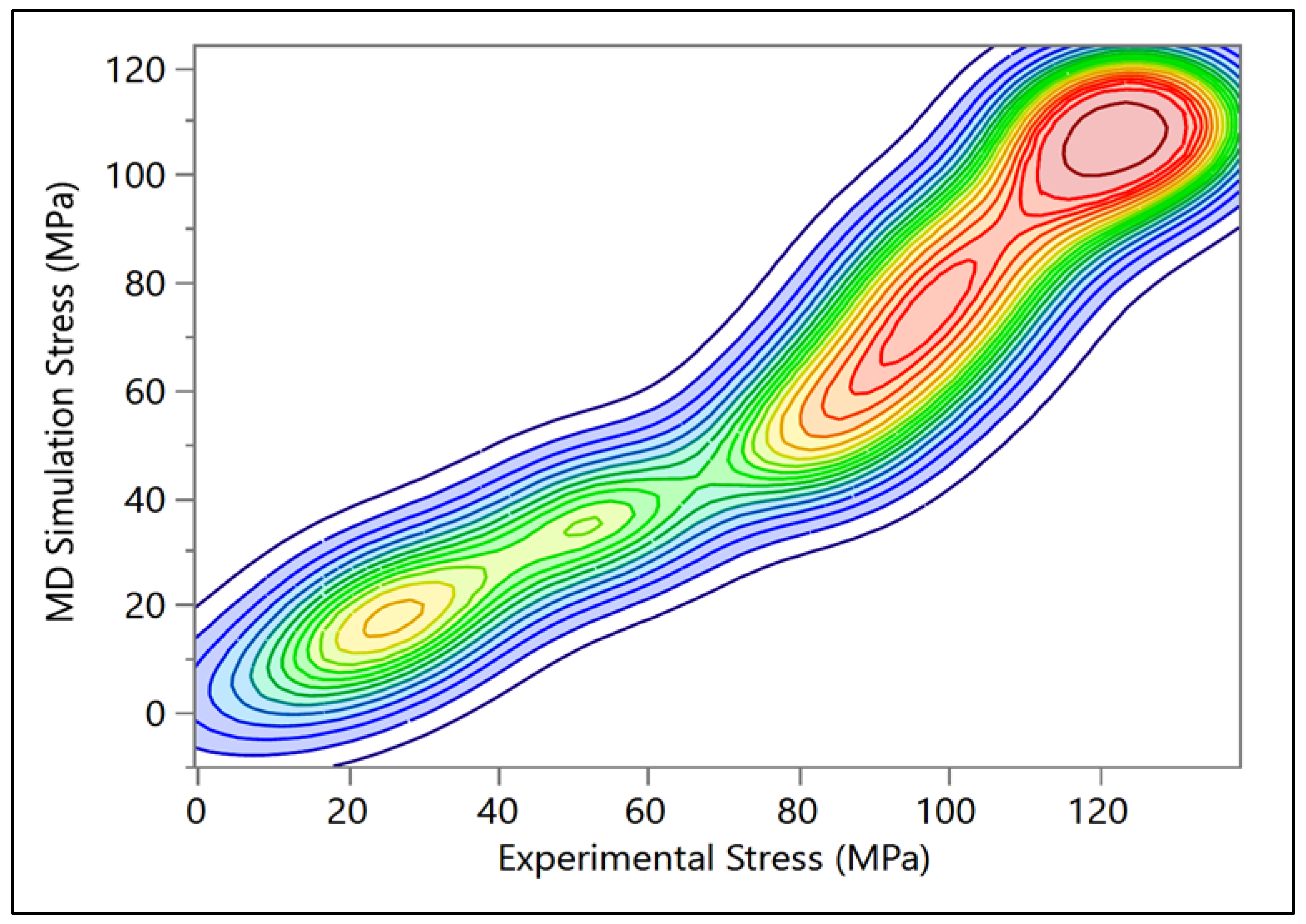
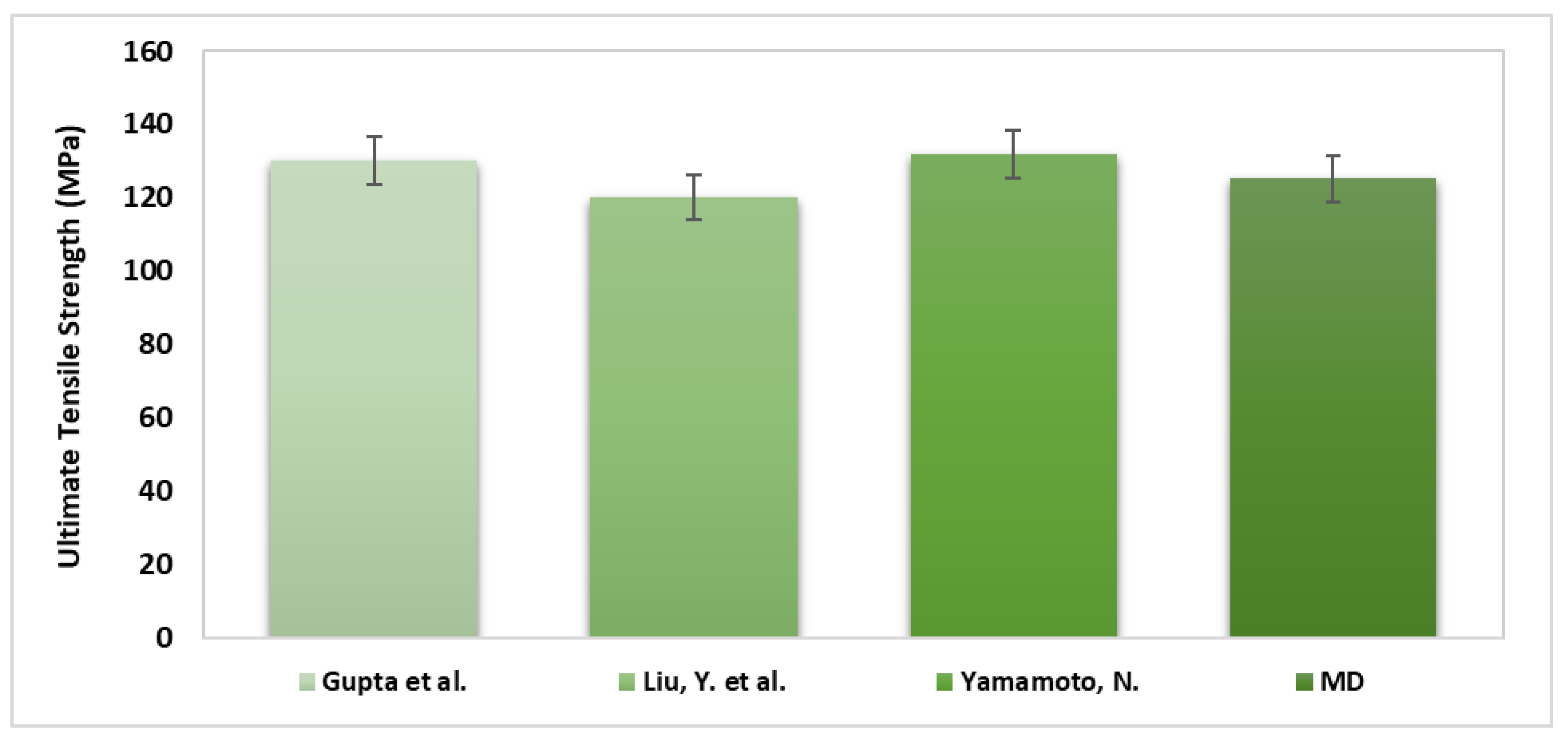
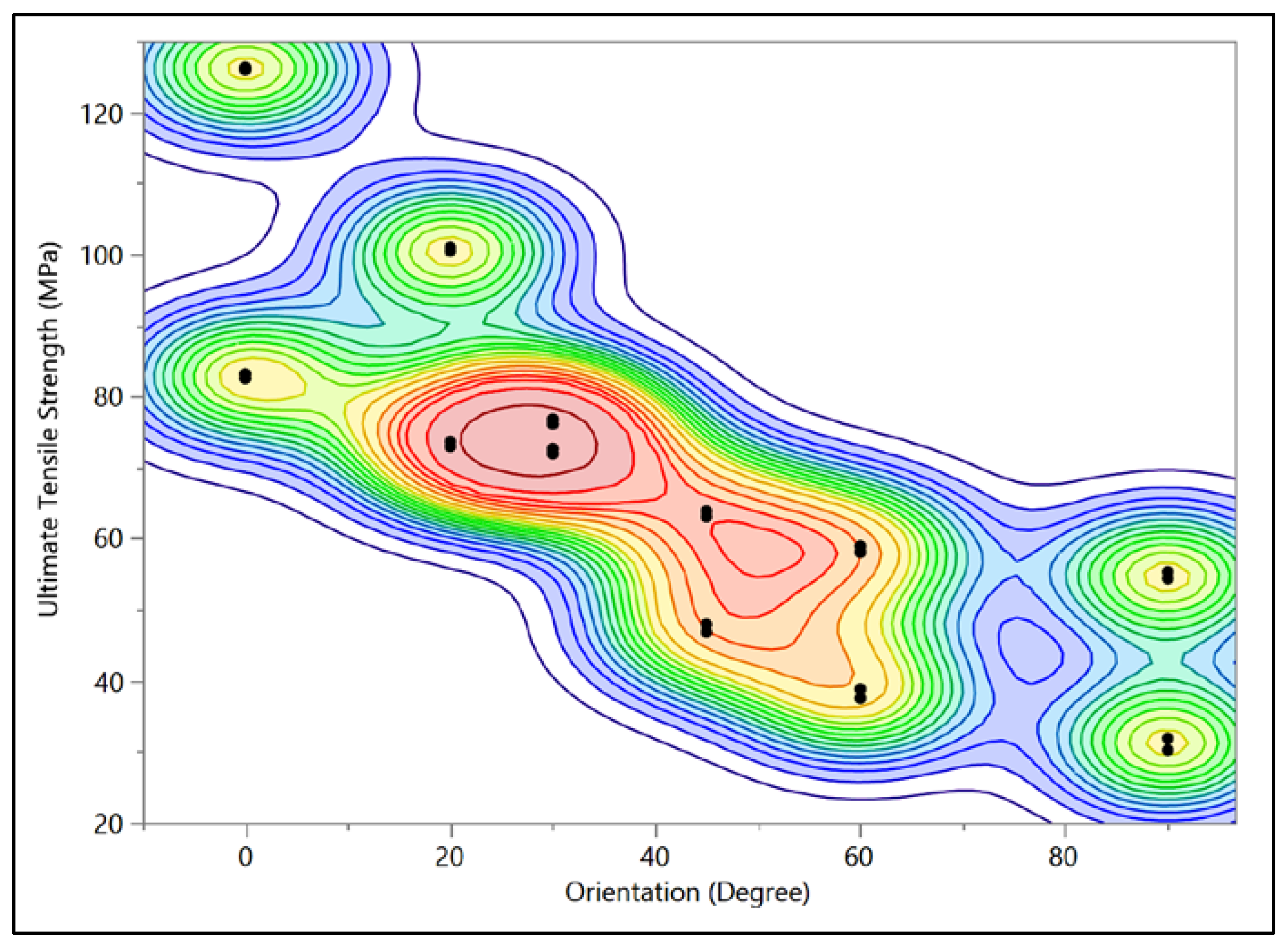

| Forcefield Parameters | Definition |
|---|---|
| kb, kθ, kUB, kω, kφ | Force constants |
| ro | i and j equilibrium bond length |
| θo | Equilibrium bond angle |
| ro | i and k equilibrium bond length |
| ωo | Equilibrium improper torsion angle |
| ri,j | i and j distance |
| ri,k | i and k distance |
| θi jk | i, j and k bond angle |
| φ | Dihedral angle |
| ω | Improper torsion angle |
| qi, q j | ith and jth particles charges |
| εo | Vacuum dielectric constant |
| εi j | Minimum of the van der Waals term |
| Rmin,i,j | Zero of the van der Waals term |
| Parameter | Values |
|---|---|
| a | 9.4214 A° |
| b | 2a |
| c | 6.8814 A° |
| γ | 120° |
| The Amino Acids Sequence | |
|---|---|
| α1 | PRO HYP GLY PRO HYP GLY PRO HYP GLY PRO HYP GLY GLU LYS GLY PRO HYP GLY PRO HYP GLY PRO HYP GLY PRO HYP GLY PRO HYP GLY |
| α2 | PRO HYP GLY PRO HYP GLY PRO HYP GLY PRO HYP GLY GLU LYS GLY PRO HYP GLY PRO HYP GLY PRO HYP GLY PRO HYP GLY PRO HYP |
| Ca | OH | |||
|---|---|---|---|---|
| Orientations | Un Hydrated | Hydrated | Un Hydrated | Hydrated |
| 0° | 3.526 | 2.972 | 3.516 | 2.945 |
| 20° | 2.804 | 2.608 | 2.819 | 2.628 |
| 30° | 2.443 | 2.272 | 2.425 | 2.222 |
| 45° | 1.782 | 1.674 | 1.761 | 1.709 |
| 60° | 1.645 | 1.388 | 1.622 | 1.339 |
| 90° | 1.543 | 1.080 | 1.519 | 1.137 |
| Orientation Angle (Degree) | Hydration | R-Square |
|---|---|---|
| Hydrated | ||
| 0° | = 2990295 − 3278034 + 1181253 − 170372 + 1333.9− 8.3447 | R2 = 0.863 |
| 20° | = −8E+06 + 9E+065 − 3E+064 + 6248533 − 521972 + 1993− 3.8355 | R2 = 0.6849 |
| 30° | = −244724 + 158143 − 3823.32 + 632.3x − 4.9454 | R2 = 0.6584 |
| 45° | = −302095 + 142894 − 545.523 − 613.532 + 183.59− 0.4357 | R2 = 0.6857 |
| 60° | = 956355 − 1047594 + 376833 − 5406.72 + 421.3− 2.5951 | R2 = 0.8649 |
| 90° | = 493485 − 534254 + 183943 − 26682 + 330.08− 1.7434 | R2 = 0.7265 |
| Un-hydrated | ||
| 0° | = −6232396 + 8360395 − 4188994 + 980723 − 119332 + 1087.6− 3.508 | R2 = 0.9771 |
| 20° | = −9469266 + 1E+065 − 6284934 + 1431933 − 154052 + 996.93− 1.2921 | R2 = 0.8991 |
| 30° | = −4321876 + 5543745 − 2643624 + 579253 − 6458.12 + 628.91+ 0.1731 | R2 = 0.9134 |
| 45° | = −4313546 + 5731495 − 2807534 + 619333 − 5812.12 + 233.81− 1.4616 | R2 = 0.8757 |
| 60° | = −4518366 + 6190885 − 3170774 + 751623 − 8279.72 + 490.36− 3.6675 | R2 = 0.9745 |
| 90° | = 2602166 − 4441125 + 2709524 − 722113 + 7979.62 − 125.77+ 2.9277 | R2 = 0.819 |
Publisher’s Note: MDPI stays neutral with regard to jurisdictional claims in published maps and institutional affiliations. |
© 2022 by the authors. Licensee MDPI, Basel, Switzerland. This article is an open access article distributed under the terms and conditions of the Creative Commons Attribution (CC BY) license (https://creativecommons.org/licenses/by/4.0/).
Share and Cite
Hamandi, F.; Goswami, T. Hierarchical Structure and Properties of the Bone at Nano Level. Bioengineering 2022, 9, 677. https://doi.org/10.3390/bioengineering9110677
Hamandi F, Goswami T. Hierarchical Structure and Properties of the Bone at Nano Level. Bioengineering. 2022; 9(11):677. https://doi.org/10.3390/bioengineering9110677
Chicago/Turabian StyleHamandi, Farah, and Tarun Goswami. 2022. "Hierarchical Structure and Properties of the Bone at Nano Level" Bioengineering 9, no. 11: 677. https://doi.org/10.3390/bioengineering9110677
APA StyleHamandi, F., & Goswami, T. (2022). Hierarchical Structure and Properties of the Bone at Nano Level. Bioengineering, 9(11), 677. https://doi.org/10.3390/bioengineering9110677








